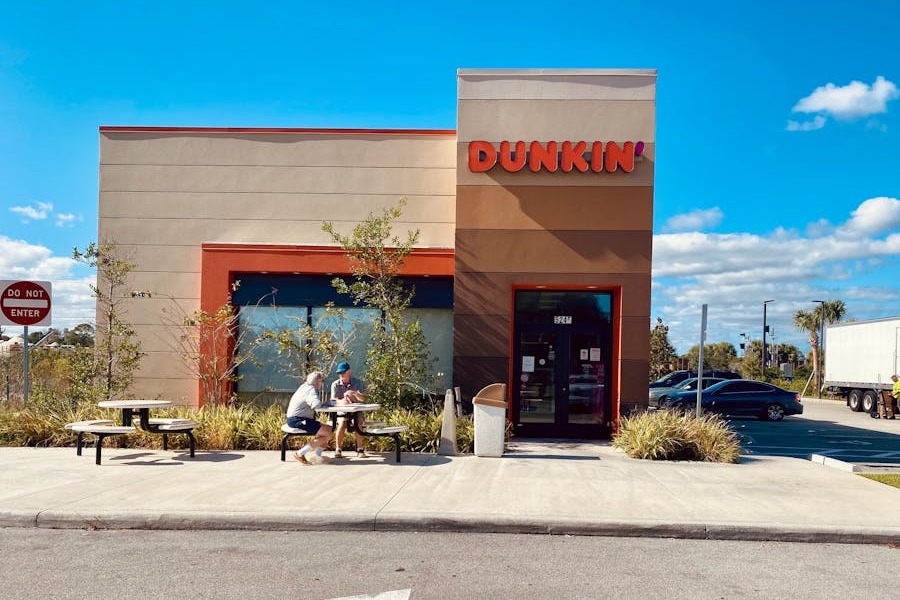
Why did Dunkin’ change its name? This question has sparked curiosity among loyal customers and marketing experts alike. Dunkin’ Donuts, a household name for decades, announced in 2018 that they would drop the word “Donuts” from their name, rebranding simply as “Dunkin’.” This move was part of a broader strategy to modernize its image, appeal to a younger demographic, and align with evolving customer preferences.
The rebrand reflects Dunkin’s shift from being solely a donut-focused chain to becoming a broader beverage and snack destination. With coffee sales driving a significant portion of its revenue, this name change symbolizes the company’s commitment to embracing its identity as a beverage-first brand while maintaining its iconic status. In this article, we’ll dive deep into why Dunkin’ made this bold decision, how it aligns with their long-term goals, and what it means for customers and the industry.
Why did Dunkin’ change their name?
Dunkin’ changed its name to reflect a broader focus on beverages and snacks, rather than being exclusively known for donuts. The move aligns with their strategy to modernize the brand, appeal to younger customers, and emphasize their coffee offerings, which account for a significant portion of their sales.
The Evolution of Dunkin’s Brand Identity
Dunkin’ Donuts has been an integral part of American coffee culture for more than 70 years. Established in 1950, the brand initially built its reputation on its iconic combination of donuts and coffee. Over time, Dunkin’ recognized the need to adapt to changing consumer preferences and gradually expanded its menu. Today, the brand offers a variety of options, including sandwiches, bagels, and a wide range of beverages. The decision to rebrand as simply “Dunkin’” reflects this evolution, signaling a shift beyond its original focus on donuts while maintaining its strong ties to its heritage.
The choice to simplify the name wasn’t made hastily but was part of a deliberate, strategic transition. For years before the official announcement, customers casually referred to the brand as “Dunkin’.” This organic shorthand demonstrated how the abbreviated name already resonated with its audience, making the rebrand feel natural and intuitive. By formally adopting the streamlined name, the company solidified its identity in a way that aligned with consumer perception.
The rebrand also speaks to Dunkin’s ambition to remain competitive in an increasingly crowded market. With coffee sales now accounting for a significant portion of its revenue, the company has positioned itself as a major player in the beverage industry. Simplifying the name to “Dunkin’” allows the brand to emphasize its role as a go-to destination for coffee and other beverages, catering to the needs of busy, on-the-go customers.
Moreover, the decision aligns with Dunkin’s long-term goals of innovation and growth. By embracing a modernized identity, the brand is better equipped to appeal to younger, trend-conscious consumers while maintaining its appeal to loyal customers. This thoughtful evolution ensures that Dunkin’ remains relevant and competitive while honoring its roots as an enduring symbol of American coffee culture.
The Strategic Reasons Behind the Name Change
Modernizing the Brand for a New Era
Dunkin’ embarked on a rebranding journey to stay relevant and attract a younger, more health-conscious audience. By dropping “Donuts” from its name, the brand embraced simplicity and modernity, aligning itself with contemporary branding trends. This strategic move was designed to reflect the evolving tastes of its customers, who increasingly prioritize convenience and a clean, sleek aesthetic in their brand interactions. The new name conveys a broader focus while maintaining the familiarity that customers love.
Shifting the Spotlight to Beverages
Coffee has become the heart of Dunkin’s business, with nearly 60% of its revenue coming from beverage sales. Recognizing this, the company repositioned itself as a beverage-first brand. The rebranding highlights Dunkin’s commitment to catering to the growing demand for specialty drinks, including lattes, cold brews, and plant-based options. The simplified name underscores their role as a go-to coffee destination while subtly signaling an evolution beyond traditional breakfast offerings.
Standing Out in a Competitive Market
The coffee industry is fiercely competitive, with brands like Starbucks dominating the landscape. Dunkin’s rebrand was essential to differentiate itself and carve out a unique identity. The new name positions Dunkin’ as a versatile and innovative brand, capable of offering more than just donuts. By emphasizing its wide range of menu items, including premium beverages, sandwiches, and baked goods, Dunkin’ appeals to customers seeking variety without compromising quality.
Building a Consistent Global Identity
As Dunkin’ continues to expand its presence internationally, the rebrand simplifies its global image. A shorter, more universal name like “Dunkin’” is easier to recognize, remember, and translate across cultures and languages. This consistency enhances the brand’s appeal in new markets, where simplicity and clarity are crucial for building trust and recognition. The streamlined name reflects Dunkin’s ambition to become a globally renowned coffee and beverage leader.
Through this rebranding effort, Dunkin’ demonstrates its ability to adapt and thrive in a changing market while staying true to its roots. The move signals a fresh, dynamic chapter for the brand, resonating with loyal customers and inviting new ones to experience its modern identity.
What the Name Change Means for Customers
- Enhanced Offerings: The rebrand doesn’t signify the end of donuts at Dunkin’; instead, it marks the beginning of a more diverse and exciting menu. Customers can still savor their favorite classic treats while exploring a broader range of offerings. The expanded menu includes a variety of specialty beverages, snacks, and sandwiches, designed to appeal to a wider audience. From indulgent donuts to refreshing cold brews and savory breakfast options, Dunkin’ ensures there’s something for everyone. This blend of tradition and innovation allows the brand to cater to loyal customers and attract new ones seeking variety.
- Streamlined Experience: At its core, Dunkin’ has always been about speed and convenience. The updated name reflects this commitment to serving on-the-go customers efficiently. By simplifying its branding, Dunkin’ reinforces its identity as a destination for quick, high-quality options that fit seamlessly into busy lifestyles. Whether it’s grabbing a coffee before work or enjoying a snack during a road trip, Dunkin’s streamlined approach ensures customers get what they need without unnecessary delays.
- Consistency Across Locations: The shorter name is a strategic choice that creates a cohesive experience for Dunkin’ customers worldwide. As the brand expands its global footprint, the simplified identity makes it easier to recognize and connect with. Whether in the United States, Asia, or Europe, customers can expect the same quality, service, and familiar logo. This consistency builds trust and reinforces Dunkin’s reputation as a reliable choice no matter where you are.
- Focus on Innovation: Dunkin’s rebrand underscores its dedication to staying ahead of industry trends through continuous innovation. The company invests in developing unique menu items that cater to evolving tastes and dietary preferences. From plant-based breakfast options to creative seasonal drinks, Dunkin’ ensures its offerings remain fresh and exciting. This forward-thinking approach keeps the brand competitive and strengthens its position as a leader in the quick-service coffee and snack market.
How the Rebrand Was Rolled Out
Dunkin’ approached its rebranding strategy with careful planning and execution, using a phased rollout to ensure a smooth transition. Initially, the company tested the changes in select stores, gathering feedback and gauging customer reactions. This measured approach allowed Dunkin’ to refine its strategy before making an official announcement. The rebrand included updated logos, signage, and packaging, all designed to reflect the streamlined identity of the brand. By dropping “Donuts” from its name, Dunkin’ aimed to emphasize its broader offerings, particularly coffee and beverages, while still celebrating its heritage.
Marketing played a crucial role in communicating the rebrand’s vision. The tagline “America Runs on Dunkin’” was front and center, reinforcing the brand’s role in the daily lives of its customers. Campaigns showcased the brand’s commitment to being more than just a donut shop by highlighting its coffee innovations, convenience, and modernized experience. These efforts underscored Dunkin’s ambition to remain a staple in consumers’ routines while appealing to a wider audience.
A significant part of the rebrand’s success stemmed from Dunkin’s use of digital platforms and social media. These channels allowed the brand to engage directly with younger audiences and create buzz around the new identity. Dunkin’ leveraged interactive content, including polls, giveaways, and user-generated posts, to build excitement and foster community involvement. This digital-first approach ensured that the rebrand resonated with tech-savvy consumers while keeping the brand relevant in a competitive market.
Despite the modernized branding, Dunkin’ was careful to reassure its loyal fans that donuts remained an integral part of its offerings. By blending innovation with tradition, the company struck a balance that appealed to both long-time customers and new audiences. The rebrand not only refreshed Dunkin’s image but also reinforced its position as a beloved, go-to destination for coffee, breakfast, and more. The careful execution of the rebrand demonstrates Dunkin’s ability to evolve while staying true to its core values.
The Impact of the Name Change on Dunkin’s Business
1. Customer Response: The rebrand initially garnered mixed reactions from customers, as many long-time patrons were hesitant about the shift in identity. However, Dunkin’ addressed these concerns by ensuring that their signature products, especially donuts, remained a core part of the brand. Over time, the modernized branding and streamlined name grew on customers, particularly younger audiences who resonated with the fresh and updated look. By maintaining their commitment to quality and convenience, Dunkin’ successfully reassured loyal patrons while attracting new customers seeking a contemporary dining experience.
2. Financial Performance: The rebrand had a positive impact on Dunkin’s financial performance, particularly in the beverage segment. The focus on coffee and other drink innovations, coupled with updated marketing campaigns, resulted in increased sales. Foot traffic to stores also saw a notable boost as the rebrand attracted attention and curiosity. The refreshed identity resonated with Dunkin’s target audience, positioning the brand as a strong competitor in the quick-service industry. This financial growth validated the company’s decision to modernize its image while staying true to its roots.
3. Industry Influence: Dunkin’s rebrand did more than elevate its status; it set a precedent for other legacy brands. The company’s ability to adapt to evolving consumer preferences while preserving its heritage-inspired competitors across various industries to reevaluate its branding strategies. Dunkin’ showcased the importance of balancing tradition with innovation, proving that even well-established brands must remain agile in a fast-changing market. The rebrand’s success highlighted the value of customer-centric approaches and the need for businesses to stay relevant in an increasingly digital and competitive landscape.
Final Remarks
The decision to change their name from Dunkin’ Donuts to simply Dunkin’ represents a significant step in the brand’s evolution. By focusing on beverages and modernizing their image, Dunkin’ ensures it remains relevant in an ever-changing market. The rebrand is more than just a name change—it’s a reflection of their commitment to innovation, customer satisfaction, and long-term growth.
FAQs
Q: Why did Dunkin’ drop “Donuts” from their name?
A: Dunkin’ dropped “Donuts” to emphasize its beverage offerings and align with its strategy to be a modern, all-day destination.
Q: Are donuts still available at Dunkin’?
A: Yes, donuts are still a core part of Dunkin’s menu, even after the name change.
Q: When did Dunkin’ officially change its name?
A: Dunkin’ announced the name change in 2018, with the rebranding rolling out globally in 2019.
Q: Did the name change impact Dunkin’s popularity?
A: The rebrand has positively influenced Dunkin’s popularity, especially among younger audiences and coffee enthusiasts.
Q: What was the main reason for Dunkin’s rebrand?
A: The primary reason was to modernize the brand, focus on beverages, and position Dunkin’ as a versatile, global coffee and snack chain.






